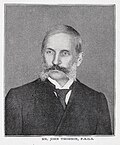|
“
|
The
Clock-tower
, designed by Mr. Rawlings in 1861, is a great ornament to the city, the clock too, when regulated properly, is of no inconsiderable service. It has, however, been a victim of the climate, and is liable to fits of indisposition, resting from its duties at the most inconvenient seasons, as if unable to contend against the heat. The tower is seen to adbantage form the harbour, and the lighted dial of the clock forms a good landmark to guide the benighted steersman to the landing steps at Pedder Wharf. In the street which conducts to the clock tower from the wharf stand some of the oldest buildings in the colony. On the right of this picture is the residence occupied lately by Messrs. Hunt & Co. In the foreground to the left, is shown part of the west wing of the palatial-looking building erected by
Messrs. Dent
when commerce was most flourishing in the settlement; this edifice is now tenanted by three separate mercantile houses. On the left and nearest to the tower stands the Hong Kong Hotel, constructed after the model of large hotels in London. It has not proved to the shareholders a very profitable undertaking, being on a scale too vast for the requirements of the place. It is rented and conducted by a Chinaman, and none but Chinese cooks and waiters are employed. The management is good and the hotel comfortable. To the visitor, the large dining hall presents an animated and interesting scene, and he finds on further experience that the arrangements are perfect and the fare unexceptionable. The native waiters are remarkable no less for promptitude and politesse than for the spotless purity of their light silk or linen robes, and the fluency of their
"pidgin" English
in which they converse; this is however a jargon intelligible only to the residents. The
turbaned
figure on the right is an
Indian
policeman, of whom there were at one time about three hundred in the force. They are now gradually being drafted off to India, and replaced by Europeans and
West-Indian
negroes. These tall Indian members of the constabulary were admitted on all hands to be highly ornamental, but proved comparatively useless for maintenance of order among the Chinese, as with one or two notable exceptions, they could neither converse in English nor the language of China
[1]
.
|
”
|


